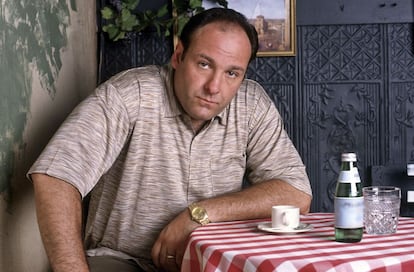Table for one: The growing trend of eating alone at restaurants
No longer frowned upon, making a reservation for yourself and enjoying a good meal in solitude is gaining popularity, as well as a recipe for receiving the royal treatment

Traditionally, the figure of a lone diner is linked to food critics or guide inspectors who arrive at a restaurant armed with a pen and a notebook, ready to make a note of every single detail of the establishment. But not anymore. Today, most of them are people who simply wish to enjoy a pleasant gastronomic experience by themselves; no conversation, no pressure, no arguing about appetizers or deserts, no rush.
This is not a new phenomenon. The Roman Lucius Licinius Lucullus was already doing it in the 1st century BC. Plutarch tells in Parallel Lives about one night in which his servants brought him a moderate dinner and he complained. He wanted abundance. They asked if he was expecting guests, to which he replied: “Don’t you know? Today, Lucullus dines with Lucullus.” He is considered one of history’s first foodies and was famous throughout the empire for his lavish banquets—with or without company. Today, this is a much more frequent sight in restaurants, where reservations for one are becoming common.

Among the many reasons for this, one stands out: “Modern societies have emphasized individualism,” said José Antonio González Alcantud, professor in the Department of Social Anthropology of the Faculty of Philosophy and Letters at the University of Granada, Spain. Historically, that has not always been the case. The specialist explained the influence that the French Revolution had in highlighting friendship and social life as fundamental needs of the human being. “It’s no surprise that the largest room that can be seen on a visit to the Paris City Hall is the banquet room,” he said. The Mediterranean culture, which takes place around a table, also focuses on this idea of sharing. “Being lonely has always been frowned upon. But now the taboo of showing solitude has been broken,” pointed out the anthropologist.
There is a magic phrase that makes all the alarms go off in a restaurant: “table for one.” The staff is often on guard against the lone diner, which for a long time has meant that whoever is coming will carry out an inspection to assess the kitchen, the room or the treatment of the staff, with the aim of giving (or not) some illustrious recognition. These days, however, googling the name of the person who made the reservation might not yield any interesting results. They probably do not work for any Michelin-style guide, nor do they bring any stars to award. In most likelihood, they just want to enjoy a nice meal. Eating or dining alone is an upward trend.
The art of eating alone
Food writer Julia Georgallis launched the podcast How To Eat Alone to explore “the uncelebrated art of eating alone” throughout a dozen chapters where, in addition to interviews and stories, she shares recipes designed to be cooked and eaten by one person—a joy for those who also eat alone at home and whose cookbooks are full of recipes for four. The New York Times has also published tips and advice for enjoying eating alone. For instance, a mobile device, a newspaper or even a book are good company for the lone diner who is not sure where to look at or what to do between courses.

“The key is whether solitude is chosen or not,” said Guillermo Fouce, professor in the Department of Social Anthropology and Social Psychology at the Faculty of Political Science and Sociology at the Complutense University of Madrid, in Spain. Fouce believes that eating alone is also an experience, even if it is not a shared one: “Why are you going to miss something just because you didn’t find anybody to do it with?” And not just a good dish at a restaurant; also a play, a movie or a concert. They work without company, too.
What is the profile of these solitary clients? “They are usually foodies or people who travel alone. They want to go somewhere, they don’t have anyone to go with, but they go anyway,” said Marco Trujillo, head waiter at the Bardal restaurant in Ronda, Spain, which has two Michelin stars. “Many ask for the tasting menu and devote that time to themselves,” added Mario Jiménez, chef at the El Faro de Cádiz restaurant in Cadiz, Spain.
In his gastronomic blog dndcomer, foodie Oriol Asensio writes about his experiences eating alone, including many positive ones. “It allows me to be more attentive to all those stimuli that surround me in the experience of eating itself: the preparation, the taste, the service, the setting, the light, the sounds, the cutlery, the diners, the bodily enjoyment,” he writes in an entry in which he talks about his experiences going to restaurants by himself in different countries. “Both the waiters and the cooks focus on the unaccompanied individuals, who could be someone from the culinary world.”
“Everyone should be offered the same, without exception. Perfection must be offered, whether it is a party of one or ten,” said Fernando Villasclaras, chef at El Lago (two Michelin stars) in Marbella, Spain. Gastronomy professionals also eat alone quite frequently. Villasclaras is a good example of this: he has been traveling through Europe in recent weeks, going from restaurant to restaurant, and understands well those who take three hours to enjoy his tasting menu on the coast of Marbella with no company other than themselves.
Sign up for our weekly newsletter to get more English-language news coverage from EL PAÍS USA Edition
Tu suscripción se está usando en otro dispositivo
¿Quieres añadir otro usuario a tu suscripción?
Si continúas leyendo en este dispositivo, no se podrá leer en el otro.
FlechaTu suscripción se está usando en otro dispositivo y solo puedes acceder a EL PAÍS desde un dispositivo a la vez.
Si quieres compartir tu cuenta, cambia tu suscripción a la modalidad Premium, así podrás añadir otro usuario. Cada uno accederá con su propia cuenta de email, lo que os permitirá personalizar vuestra experiencia en EL PAÍS.
¿Tienes una suscripción de empresa? Accede aquí para contratar más cuentas.
En el caso de no saber quién está usando tu cuenta, te recomendamos cambiar tu contraseña aquí.
Si decides continuar compartiendo tu cuenta, este mensaje se mostrará en tu dispositivo y en el de la otra persona que está usando tu cuenta de forma indefinida, afectando a tu experiencia de lectura. Puedes consultar aquí los términos y condiciones de la suscripción digital.
More information
Archived In
Últimas noticias
Most viewed
- Sinaloa Cartel war is taking its toll on Los Chapitos
- Oona Chaplin: ‘I told James Cameron that I was living in a treehouse and starting a permaculture project with a friend’
- Reinhard Genzel, Nobel laureate in physics: ‘One-minute videos will never give you the truth’
- Why the price of coffee has skyrocketed: from Brazilian plantations to specialty coffee houses
- Silver prices are going crazy: This is what’s fueling the rally











































